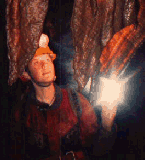
"bacon" formation in a cave
Caves are a unique habitat. There is no light, so you will not find plants in an undisturbed, natural cave. The food chain for plants starts with sunlight and photosynthesis - and if the cave is always dark, then it's a lousy habitat for a plant.
Animals still live in cave. "Troglodytes" that live exclusively in a cave live on the little bit of detritus that washes into the cave (including some plant material), prey on the animals that feed outside the cave and come inside to become dinner, or feed on bacteria that grows in the cave.
Bats use the cave for protected roosting areas, but feed outside the cave. They can create great mounds of guano underneath their roosting sites, and various forms of life from bacteria to cave crickets live on the energy provided by that imported food source.
Caves can be dry or very moist environments. The most-wet caves are those still functioning as springs, filled with water and with cave formations (speleothems) such as stalactites and stalagmites. Stalactites "stick tight" to the ceiling, growing from the top down. Stalagmites grow from the bottom up, and many caves have "columns" where the stalactites and stalagmites have grown together. "Flowstone" is a cave formation that resemble a folded curtain, and "shields" look like... shields held by old Greek warriors. Other formations can look like popcorn, or thin fibers twisted into weird corkscrew shapes ("helictites").
The formations in Virginia caves were created, in most cases, by rainwater that seeped through the soil. The water may have absorbed a little sulfur dioxide in the air, becoming "acid rain." Even neutral raindrops can become acid after landing on the ground, where the water absorbs carbon dioxide from decaying vegetation on the surface and from bacteria/other life in the soil.
The slightly-acid water can dissolve limestone, separating the calcium (Ca) atoms from the carbonate (CO3) ions. As the bedrock dissolves, spaces expand and caves grow. Later, more raindrops descending through the soil may encounter an air-filled space underground. The water can evaporate, leaving a thin film of once-dissolved calcium behind. Stalactites start as thin, hollow soda straws, with the straw getting longer as droplets of water evaporate at the tip and leave another ring of calcite behind. Once a bit of grit clogs the hollow of the soda straw, the water flows on the outside and the stalactite begins to grow wider as well as longer.
The water is essential for a living cave, where formations are still growing. With every drop of water, there is the potential for a change in the speleothems. The drip on the end of a soda straw is one place where you can see rocks grow in Virginia.
Most commercial cave tours involve walking along a paved trail, looking at formations illuminated with lights that have been hidden behind rocks or rock-colored shades. If the lights are arranged to shine through sheets of calcite stained with iron oxide, the speleothem may resemble a slab of red bacon with white layers of fat. (Luray Caverns, always looking for an angle to attract visitors, advertises it has formations that look like "fried eggs.")

"bacon" formation in a cave
The walkways help the visitors stay out of the wet mud, small streams, and pools of water - but you'll hear the cave guide say constantly "Watch your step; it's slippery here..." Cave visitors are also requested to keep their hands off the speleothems. the thin layer of grease on our fingers, if transferred to the cave formation, will cause droplets to slip off a stalactite without depositing any rock - thus killing the growth of the formation.
It's rare, but you can see speleothems form outside of caves, including at Falls Ridge Preserve in Montgomery County and on the walk down to Natural Bridge. Travertine has been deposited in the streams on the surface, by water still saturated with calcite that emerged from a nearby cave system. On the left bank of the Shenandoah River downstream of Route 50 near the upstream end of Burwell Island, a small cave has collapsed. The speleothems have been exposed and not eroded away... yet.
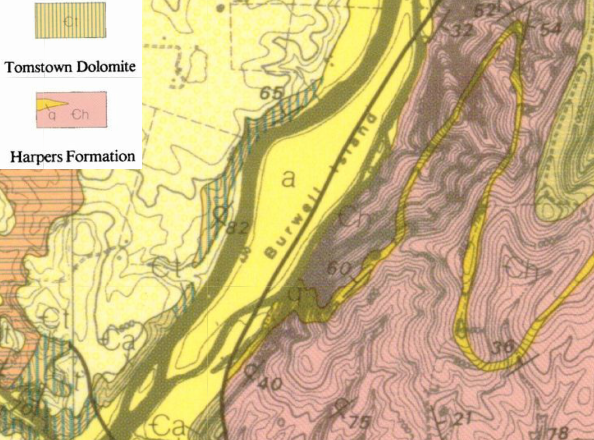
the collapsed cave opposite Burwell Island is in the limestone-rich Tomstown Dolomite to the west, not in the Harpers Formation sandstone to the east of the island
Source: US Geological Survey, Geologic map of Clarke County, Virginia
"Speleogenesis" outside of caves has also created massive, clearly-visible formations on the sides of the Three Little Gorges of the Yangtze River at Wushan, China. Groundwater, saturated with lime, evaporates when it reaches a spring on the cliffs of a grotto. When travertine is deposited faster than rainfall dissolves it, the formation continues to grow.
Closer to home, underneath the Lincoln Memorial are stalactites formed after acid rain dripped across the marble and through the cement stairs. Some stalactites had reached 7' long by 1957, just 35 years after the monument was completed.1
Commercial cave guides may claim visitors are looking at "million-year-old formations." The limestone/dolomite bedrock in which the cave formed could be 500 million years old, but the cave itself may date back to no more than 600,000 years. The formations (stalactites, stalagmites, "fried eggs," etc.) may have formed in less than 1,000 years. Tourists who look at the bottom of stalactites broken off by thoughtless collectors/tourists in the last century may find soda straws that are younger than their grandparents.
Stalactites have formed underneath Metrorail platforms in Northern Virginia. The calcium carbonate in mortar has dissolved, but as water droplets evaporated underneath the platform the CaCO3 was deposited in the form of a soda straw.
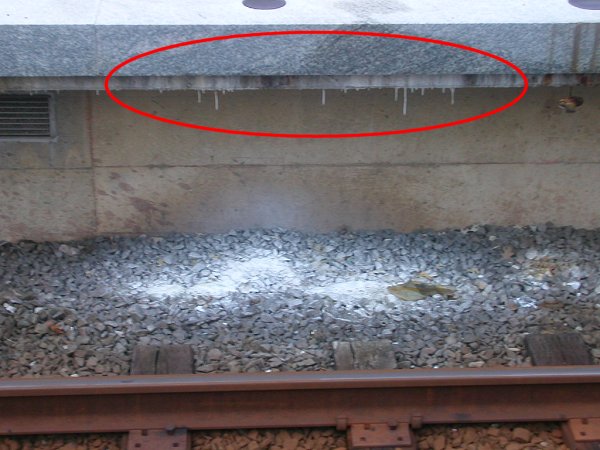
soda straws forming at West Falls Church Metro station (source material: cement, which includes calcium carbonate)
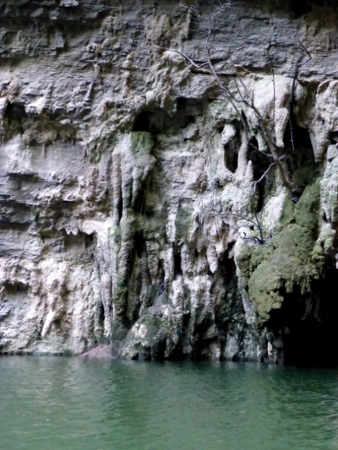
travertine formations clearly exposed on the surface (Yangtze River in China)
Cave formations can form outside of caves... and plants can grow inside caves, even where there is absolutely no sunlight.
If the lights in a commercial cave are left on regularly, then algae spores can germinate and grow on the cave formations in the moist, protected-from-grazing-animals environment. For the algae, a cave can be a stable and safe environment to grow - so long as there is light of some sort. In the glare of the commercial cave lights, the chlorophyll used by the algae to photosynthesize food can add an unnatural green color and foreign texture to cave formations.
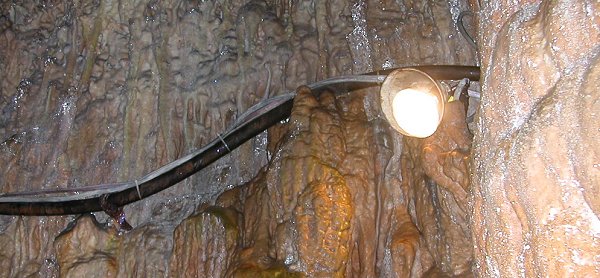
artificial light introduced to cave environment (Grand Caverns at Grottoes, Virginia)
Why would an animal live in a cave? Salamanders, fish, and insects are protected against predators in a cave, making the cave an attractive location. "Obligate" cave dwellers are those animals that have evolved to the point where they are no longer able to survive outside the cave, often because they have become blind. They are "obliged" to live in the dark caves. Animals adapt to their circumstances.
The Lee County cave isopod (Lirceus usdagalun) lives in only two cave systems and two springs in The Cedars region of southwestern Virginia, part of the Valley and Ridge physiographic province (not in the Appalachian Plateau). Caves and springs in the area are connected by groundwater moving 130 feet/hour, though the Thompson Cedar Cave may not be directly connected with the Surgener-Gallohan system six miles away. The Lee County cave isopod was extirpated from Thompson Cedar Cave after dissolved oxygen levels in the water was reduced by runoff from sawdust piles of a local sawmill, but rediscovered there in 2002 after most sawdust was removed.2
The rare Lee County isopod is listed as a Federally "threatened" species. It evolved over time from a species that once lived on the surface, and developed unique characteristics. Every Lee County isopod today is blind - none of those freshwater crustaceans wastes any energy growing and maintaining eyes. The isopods waste no energy on pigmentation either; they are ghostly white.
A cave is always pitch black, so what's surprising about the evolutionary process redirecting energy away from useless eyes? Why bother with body color, when no potential mate will be attracted and no potential rival will be deterred?
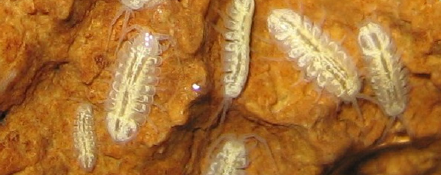
Lee County isopods, unpigmented and eyeless
Source: Virginia Natural Heritage Program, Lee County Cave Isopod
Caves also provide a steady temperature, reflecting the average temperature of the area. The average annual temperature of Virginia ranges between 52-58 degrees on the Fahrenheit scale of temperature. In the summer, the asphalt in the parking lot may be hot enough to melt tar bubbles, and in the winter there could be a sheet of ice on that same parking lot - but a few feet below ground level, the soil temperature will stay steady across Virginia.
Only near the entrance of a cave will the temperature change significantly between day and night, or with the seasons. Virginia caves are about 56 degrees, every day, every hour - a little cooler in Frederick County, a little warmer down south in Washington County. The one commercial cave in North Carolina, Linville Caverns, is always 52 degrees. Linville Cave is higher in the mountains, so the average temperature there is cooler than most Virginia caves even though it is located further south. The one commercial cave in Maryland, Crystal Grottoes, averages 55 degrees.3
Caves are not always a static environment; they can change dramatically at times. A summer thunderstorm can result in a rush of water into a cave, importing leaf debris and raising the temperature in the cave. The rainwater is coming from the outside, so it may be much warmer than 56 degrees in summertime.
A flood in a cave can drown bats and break cave formations. WARNING: cavers can also be caught and drowned. In 1995, a caver was trapped by high water in Barberry Cave in Bath County. Beware of entering wild caves if rainstorms are likely in the area. While you're underground, you won't hear the thunder and know when to head back.4
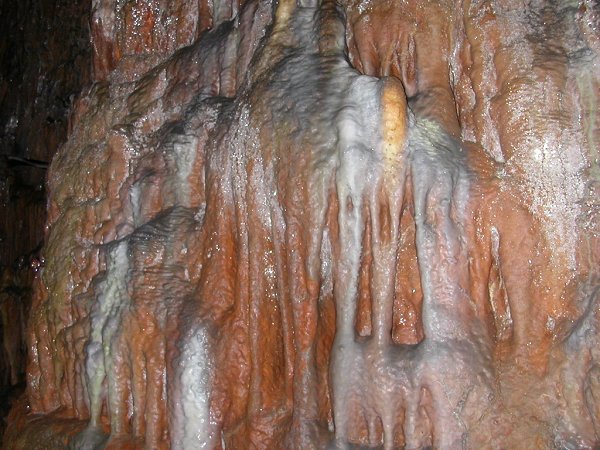
cave flowstone at Grand Caverns, Virginia
created by white calcium carbonate and red iron oxide (rust) precipitating from groundwater
In rural areas, many residents pump their water from wells that have been drilled 100-300 feet underground. That's far below the level where the soil warms up in the summer or cools in the winter, so the water from the well will be a consistent temperature - around 56 degrees in Virginia.
An energy-efficient home can use a geothermal well to cool the house in the summer. The air conditioning system can rely upon 56° water from the well to cool the house. In the winter, the groundwater system can use the same 56° water to exchange heat with a heat pump, substantially reducing utility bills. Water pumped from underground at 56° often contains more heat than the air outside in the winter.
On very cold winter days, normal heat pumps can not draw much heat from dry, frigid outside air. They rely upon a supplemental electrical heater, essentially heating the outside air so the heat pump will work. In contrast, a geothermal system eliminates electrical heating costs and keeps electrical bills low by pumping warm (56°) water from the geothermal well to the heat exchanger.
Mammoth Cave National Park in Kentucky once circulated air from the cool underground cave into the visitor center, for a natural form of air conditioning. That made sense, until the National Park Service discovered that the cool cave air included radon, a natural form of radioactivity. Brief visits to the cave were fine, but people working a full day in the cave or the visitor center were thought to be at risk. Park ranger work schedules - and the air conditioning system - have been altered since that discovery.5